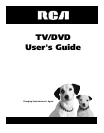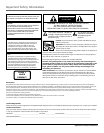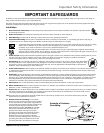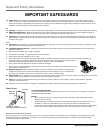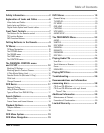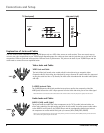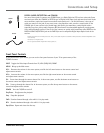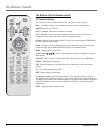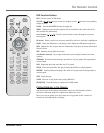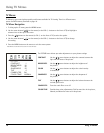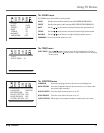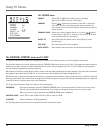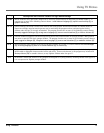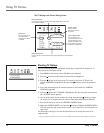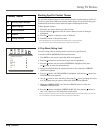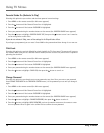
Important Safety Information
Important Safety Information 3
IMPORTANT SAFEGUARDS
In addition to the careful attention devoted to quality standards in the manufacture of your product, safety is a major factor in the design of
every product. However, safety is your responsibility too.
This sheet lists important information that will help to assure your enjoyment and proper use of the product and accessory equipment. Please
read them carefully before operating and using your product.
Installation
1Read and Follow Instructions—All the safety and operating instructions should be read before the product is operated. Follow
all operating instructions.
2Retain Instructions—The safety and operating instructions should be retained for future reference.
3Heed Warnings—Comply with all warnings on the product and in the operating instructions.
4Polarization/Grounding—This product is equipped with either a polarized, non-polarized, or a grounding type power cord plug. If
equipped with the non-polariz-ed type (two blades of identical size), the following does not apply.
•A polarized power plug (two blades, one wider than the other) will fit into a power receptacle only one way. This is a safety
feature. Do not defeat it. If you are unable to insert the plug fully, try reversing it, or have an electrician change the
receptacle. If you need an extension cord, use only a polarized extension cord.
•A grounding type power plug (two blades and a round pin) will fit only into a grounding type receptacle with matching
openings. This is a safety feature. Do not defeat it. You may need an electrician to install a grounding type receptacle. If you
need an extension cord, use only a grounding type extension cord.
5Power Sources—This product should be operated only from the type of power source indicated on the product's marking label. If you are
not sure of the type of power supply to your home, consult your dealer or local power company. For products intended to
operate from battery power, or other sources, refer to the operating instructions.
6Overloading—Do not overload wall outlets or extension cords as this can result in a risk of fire or electric shock. Overloaded
AC outlets, extension cords, frayed power cords, damaged or cracked wire insulation, and broken plugs are dangerous. They
may result in a shock or fire hazard. Periodically examine the cord, and if its appearance indicates damage or deteriorated
insulation, have it replaced by your service technician.
7 Power-Cord Protection—Power-supply cords should be routed so that they are not likely to be walked on or pinched by items placed upon
or against them. Pay particular attention to cords where they are attached to plugs, convenience receptacles and at the point where they
exit from the product.
8Ventilation—Slots and openings in the enclosure are provided for ventilation to ensure reliable operation of the product and to protect it
from overheating. These openings must not be blocked or covered. These openings should never be blocked by placing the product on a
bed, sofa, rug, or other similar surface. This product should never be placed near or over a radiator or heat register, or another heat source
(including amplifiers). This product should not be placed in a built-in instal-lation such as a bookcase or equipment rack unless proper
ventilation is provided or the product manufacturer’s instructions have been followed.
9Attachments—Do not use attachments unless recommended by the product manufacturer as they may cause hazards.
10 Water and Moisture—Do not use this product near water—for example, near a bath tub, wash bowl, kitchen sink or laundry tub, in a wet
basement, or near a swimming pool and the like.
11 Accessories—Do not place this product on an unstable surface or support. The product may fall, causing serious injury to a child or adult as
well as serious damage to the product. Any mounting of the product should follow the manufacturer’s in-structions and use only
a mounting accessory recommended by the manufacturer.
11A A product and cart combination should be moved with care. Quick stops, excessive force, and uneven surfaces may cause the
product and cart combination to overturn.
12 Outdoor Antenna Grounding—If an outside
antenna or cable system is connected to the product,
be sure the antenna or cable system is grounded so
as to provide some protection against voltage surges
and built-up static charges. Section 810 of the
National Electrical Code, ANSI/NFPA No. 70-1984
(Section 54 of Canadian Electrical Code, Part 1)
provides information with respect to proper
grounding of the mast and supporting structure,
grounding of the lead-in wire to an antenna-
discharge unit, size of grounding conductors,
location of antenna-discharge unit, connection to
grounding electrodes, and requirements for the
grounding electrode. See example on the right.
Example of Antenna
Grounding



